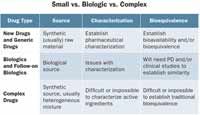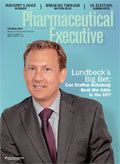Complex Drugs and Biologics: Policy Considerations in Brazil
The Brazilian government's policy on biologics doesn't adequately address non-biologic complex drugs. Additional guidance is needed to bring these important medicines to market.
The development of affordable biologics and biosimilars are of particular interest in Brazil as the utilization of these products represents a significant portion of the Brazilian Ministry of Health's total budget. In order to increase access to these medications, the Agência Nacional de Vigilância Sanitária (ANVISA) released guidelines in December 2010 that further define a pathway to bring biologics and subsequent entry biosimilar medications to market in Brazil.

J. Michael Nicholas
The guidelines require applicants to provide a record of whole quality information and necessary clinical data for their proposed biologic or biosimilar product. While this is an imperative first step in bringing affordable versions of these medications to the Brazilian market, additional guidance is needed from ANVISA to encompass complex medications that fall outside the realm of biologics. These medications, namely non-biologic complex drugs (NBCDs), possess large synthetic molecules, including synthetic proteins, and are typically comprised of higher order structures.
As a result, NBCDs are often difficult to fully characterize. Taking into considering these regulatory complications, additional guidelines for development of these therapies in Brazil will ensure patients secure affordable medications that are proven safe and efficacious.
Small molecule, biologic, and NBCDs medications
Small molecule therapies, like aspirins, are manufactured by chemical synthesis and generic equivalence can be demonstrated by relatively simple, straightforward testing. While complex medications are also developed via chemical synthesis in laboratories, they can possess primary, secondary, and tertiary structures, similar to biologics, and may contain an enormous number of polypeptide sequences. NBCDs are often comparable to biologics in size, but the latter are derived from living matter, or manufactured in living cells using recombinant DNA biotechnologies rather than being chemically produced. The figure on page 65 depicts the differences between complex drugs, biologics, and small molecule medications.
As illustrated, it can be difficult, and in some cases impossible, to characterize the active ingredients of NBCDs. Even slight modifications in the amino acid sequences of molecular weight of these products can have major safety and efficacy implications. Furthermore, changes in the manufacturing process conditions for NBCDs can cause significant changes to the primary and secondary structures, leading to challenges in establishing bioequivalence for follow-on products.
One example of an NBCD is glatiramer acetate (Copaxone), indicated for relapsing remitting multiple sclerosis (RRMS) and part of the glatiramoid class of drugs. Glatiramer acetate is a heterogeneous mixture of polypeptides comprising of the four amino acids L-glutamic acid, L-alanine, L-lysine and L-tyrosine. The constituent amino acid sequences and chain lengths of polypeptides in glatiramer acetate vary and the pharmacologically active epitopes cannot be identified. Currently available analytical technology is incapable of characterizing all of the active sequences of this product, so pharmaceutical equivalence cannot be assured by follow on manufacturers. Consequently, the only way to guarantee safety and efficacy of follow on versions of glatiramer acetate would be through clinical trials with relapse rate as the clinical endpoint. However, this may not be the case for all NBCDs. When securing applications for follow on versions of NBCDs, ANVISA should determine the need for clinical trials on a case-by-case basis to reduce the amount of unnecessary spend and time by manufacturers. As a result, NBCDs possess many of the same challenges of biologics and warrant similar specifications to ensure patient safety continues to remain a top priority. When securing applications for follow-on versions of NBCDs, ANVISA should determine the need for clinical trials on a case-by-case basis to reduce the amount of unnecessary spend and time by manufacturers.
Regulatory framework surrounding complex drugs
Currently, ANVISA has not yet defined a pathway for follow-on versions of complex medications. The 2010 Biosimilar Guidelines released by the Brazilian regulatory agency took into account frameworks from around the world including Health Canada (Canada), EMA (Europe), CECMED (Cuba), KFDA (Korea) and the World Health Organization (WHO). In its guidelines, ANVISA outlined two potential pathways to bring biosimilars to market: the development copy for comparison path and the individual development copy path. In the development copy for comparison path, applicants are required to compare their biosimilar to the reference product by supplying information surrounding cellular origin, production process, quality parameters, and non-clinical/clinical studies.
This route enables extrapolation of therapeutic indications and was adapted from the WHO SBP Guidelines. The individual development copy path is used in instances where the biosimilar and reference product cannot be compared. With this pathway, applicants are requested to provide information surrounding the technological development of their product including production data, quality control, and non-clinical and clinical Phase I/II studies on a non-comparison basis. The data submission can then be increased or decreased according to the complexity and specific characteristics of the molecule. Currently, there is one biological product, a low molecular weight Heparin, approved under the individual development pathway and two more products under development.

On September 10-11, 2012, ANVISA and the US Food and Drug Administration (FDA) came together to discuss issues in law, regulation, and trade between the United States and Brazil surrounding food, medical devices, and pharmaceuticals. During this meeting, industry experts discussed the recent legislation, regulation, and guidance covering biosimilars, follow-on NBCDs, and the bioequivalence standards for both. Discussion at the meeting surrounded the substantially different approaches between the United States and Brazil in defining the pathway of these products. For example, unlike the United States, Brazil does not recognize a data exclusivity period for a company introducing a biologic. In addition, Brazilian law does not apply to complex drugs, a complicating factor for Brazilian innovators. Conferences of this kind are necessary to navigate the new frontiers being explored for complex drugs by regulatory authorities.
Regulatory considerations
The ability, or inability, to chemically characterize a product should determine requirements for approval of a follow-on NBCD. According to the FDA's 2012 Biosimilar Guidelines, the extent of clinical trials will depend on a number of factors including the nature and complexity of the innovative product, the degree of understanding surrounding the mechanism of action (MOA) for the follow-on product, the extent to which pharmacokinetic and pharmacodynamic testing can predict clinical outcomes, the availability of appropriate endpoints and biomarkers, and the extent of clinical experience with the innovative and follow-on product. Additionally, the importance of understanding the MOA and active portions of follow-on NBCDs cannot be overemphasized. Without this available information, the characterization process of these products is suspect.
Globally, regulatory authorities have maintained that the clinically active portions of a pharmaceutical product must be defined in order to demonstrate sameness for a follow on product. Without this essential component to the characterization of NBCDs, regulatory authorities cannot definitively know whether the follow-on product is equivalent, or even similar, to the reference drug. The issue of pharmaceutical equivalence/sameness is significant as it determines how much previous work can be relied upon for the approval of new medications. ANVISA must determine the level of necessary data on a case-by-case basis to ensure products available on the market possess adequate non-clinical and/or clinical data to ascertain sufficient safety and efficacy profiles.
Conclusion
ANVISA has made great strides in defining a regulatory pathway for biosimilars in order to bring these complex therapies to market. With continued advancements in science, more complex therapies will continue to be brought to market. Oftentimes, these complex therapies are able to provide benefits for patients that were previously unachievable. As the agency continues to further define strategy for biosimilars, distinct guidelines should be developed surrounding NBCDs to ensure that all complex products are safely regulated for patients.
J. Michael Nicholas, PhD is Senior Director, Life Cycle Initiatives at Teva Pharmaceuticals. He can be reached at mike.nicholas@tevapharm.com.
